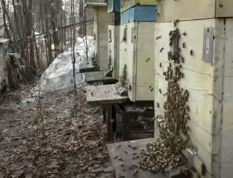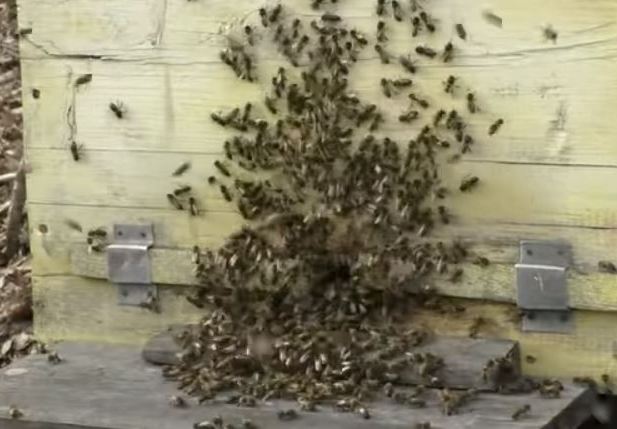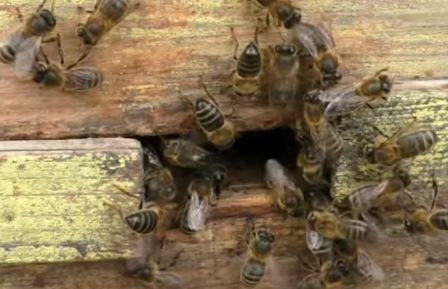The first spring flight of bees - observing the flight of bees

Every spring, beekeepers eagerly await the first spring flight of bees. Why is the first spring flight of bees so important for bees, what will the first spring flight tell the beekeeper about the progress of wintering, how can a beekeeper prepare and conduct the first spring flight of bees.
Content
- Why do bees make their first spring flight?
- The first flight of bees in the spring at what air temperature is carried out?
- Early flight of bees the wintering outdoors : pros and cons
- How to organize the first spring flight of bees
- Observation of the first spring flight of bees
- What to do with bees after their first flight in spring
Why do bees make their first spring flight?
Why do bees make their first spring flight?
After wintering, the bee colony gradually moves from dormancy to active activity. In the second half of February and early March, the queens begin to lay eggs; every day several dozen eggs appear in the cells. Then, every day, the daily egg laying increases and reaches several hundred eggs per day. The appearance of brood activates the vital activity of bees. Bees consume more and more food, make brood food, and feed the larvae. However, the development of bee colonies at the end of winter is hampered by the fact that the bees are still relatively inactive; the bees have not yet freed themselves from undigested food debris. In the hive, the brood is located in the central part of the nest.
Noticeable qualitative changes in bee colonies begin only after the first spring flight, which can also be called the cleansing flight of bees.
The first flight of bees in the spring at what air temperature is carried out
In what month do bees make their first flight? In the south, bees make their first flight, weather permitting, back in February. The further north you go, the bees make their first flight later, in March and even April.
The 2024 bee flyover in the south took place on the 10th of February, when the bees not only made a cleansing flyby of the bees, but also individual bees began to carry pollen.
So, at what temperature does a bee fly?
For the first spring flight, bees fly out on a quiet, windless, clear day, when the air temperature reaches 9-10 C and above.
During the spring flight (cleansing flight of bees), the bees first empty their large intestines, and only in the following days after the first spring flight, the bees begin to work, flying out to collect nectar and pollen.
Early flight of bees when wintering outdoors: pros and cons
Some beekeepers believe that the sooner the spring flight of bees of bees occurs, the better.
It should be noted that early flight of bees has both pros and cons. No matter how strange it may seem, the advantages of early flight of bees after wintering are also disadvantages.
The pros and cons of early flight of bees in the spring after wintering are obvious:
- If the bees have a full intestine and they can no longer hibernate, they need to fly around to empty their intestines so that there is no acute phase of nosematosis. After flying around the bees, they can be given a preventive treatment for nosematosis.
- After the flight, the family begins to actively develop, which means that the family will consume a large amount of food, which makes it necessary to feed the bees if there is a lack of food.
- Particular attention must be paid to protein feeding of bees, because bees need to grow a large amount of brood, which would replace wintering bees. If there is no protein feed due to the fact that there are no pollen carriers near the apiary or the weather is cold and the bees cannot fly out, they will not be able to raise a sufficient number of young bees and the colony will die the spring. For some reason, some beekeepers forget that the most important period of wintering a bee colony is not so much the wintering itself, but the period after the first cleansing flight of bees and until the moment when the wintering bee is replaced. Therefore, carefully study what the beekeeper needs to do in the spring.
- The beekeeper must also take care of supplying the apiary with clean water, preferably an in-hive drinking bowl, or a drinking bowl in the apiary. Because during the period when bees are feeding brood, they need water, and if there is no source of clean water, the bees will take water from various sources that are not suitable for this. This can be a source of infection of bees with dangerous diseases, and also flying for water in unfavorable weather can cause the death of a large number of flying bees, which will negatively affect the strength of the colony. In some cases, bee losses during flights in unfavorable weather can be up to 25%.
How to organize the first spring flight of bees

If bees spend the wintering outdoors, there are no big problems with bees flying around in the spring. the hives are located in old places that are familiar to bees since autumn. The beekeeper only needs to clear the area in front of the hives of snow. As a rule, there is no need to bother with the entrances either; during wintering they are open and the bees themselves will begin to fly around as the weather warms up.
If the bees spend the winter in a wintering indoors, then there are certain difficulties with the bees flying around in the spring.
First, the bees are removed from the winter hut and the hives are placed in a permanent place.
If in an apiary the hives are located at a large distance from each other (8 - 12 meters), and trees grow nearby and the hives are painted in different colors, then the flight of bees in the spring will go well and the bees, returning from the flight, will not end up in other people's hives.
If the apiary is located in an open place, where there are no landmarks for bees in the form of trees and bushes, and the hives are spaced relatively densely at a distance of 2 - 4 meters from each other and all the hives are painted the same color or similar colors, for example, red and brown , then in the apiary during the flight of bees in the spring, wandering of bees and migration may occur. Some hives will be overcrowded with bees, while other hives will have few bees left. Many queen bees will be killed by alien bees.
To prevent wandering and flight of bees during the flight of bees in the spring in a large apiary after the exhibition of bee colonies from the winter hive, there is no need to open the entrances in all hives at once. First, the entrances in the hives are opened, starting with those bee colonies that were the first to be taken out of the winter hut. By this time, these bee colonies should have calmed down, and the spring flight of bees will take place calmly and there will be no gatherings. If the bee colony is greatly disturbed when being taken out of the winter hut, you must wait to open the entrances until the bees calm down. Otherwise, bees may fly to nearby hives. The entrances for the spring flight of bees are opened first through one hive. At the moment the bee colony flies around its hive, all entrances, especially the upper entrances, must be completely open. After the spring flight of bees of the first batch of bee colonies is over, the entrances are opened in the remaining hives and make it possible to carry out the spring flight of bees for the remaining bee colonies.
Observation of the first spring flight of bees

The beekeeper should carefully observe the spring migration of bees. Careful observation of the bees during the first spring flight of bees allows the beekeeper to draw preliminary conclusions about the result of the bees' wintering and the condition of each bee colony. If there is a friendly, intensive cleansing flight of bees, when a large number of bees simultaneously fly in the air near the hive, this indicates that this bee colony has overwintered well. Poorly overwintered bee colonies are sharply distinguished by the behavior of their bees during the cleansing flight of the bees. A colony in which the queen bee has died, as well as a family that has become very weak during the winter or damaged by mice, can be identified because the bees fly very poorly, or even do not come out at all for the first spring flight of bees. At the same time, the bees are very excited and run along the alighting board , trying to find the queen. If the bees go to the first spring flight of bees unfriendly and fly sluggishly, then, most likely, the bee colony is greatly weakened due to hunger. If a putrid smell comes from the hive, and the bees defecate directly on the flight board or on the front wall of the hive, most likely the bee colony is sick with nosematosis. If bees, when trying to take off, fall to the ground and crawl around the hive, while spreading their wings, most likely there is acarapidosis in the bee colony.
What to do with bees after their first flight in spring
What to do with bees after their first flight in spring. The beekeeper must record all the results of observations of the first spring flight of bees in an apiary journal; in a large apiary, he simply will not remember how each family flew around. As soon as the mass first spring flight of bees ends, in all hives it is necessary to reduce the entrances to 2-5 cm and immediately begin the first cursory inspection of the bee colonies, first of all, inspect the unsuccessfully overwintered colonies.
Good luck to all beekeepers!
